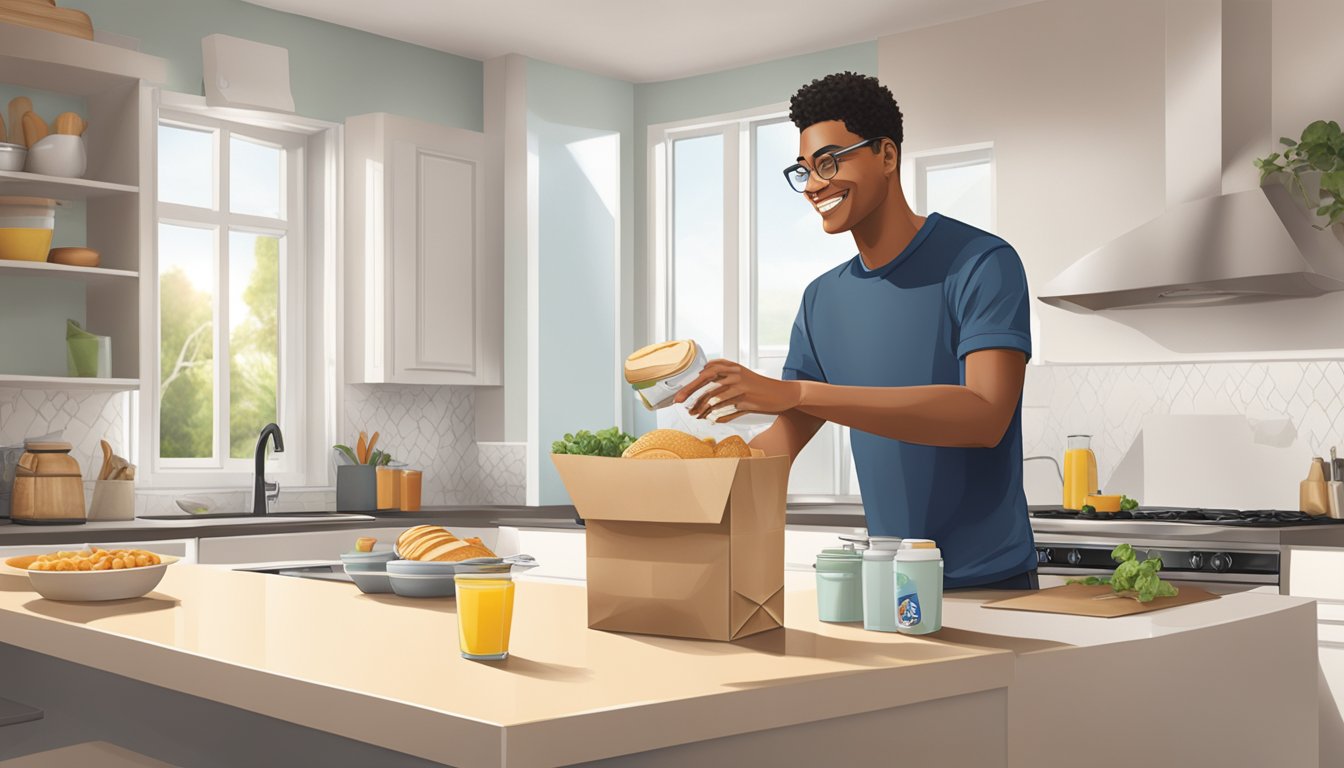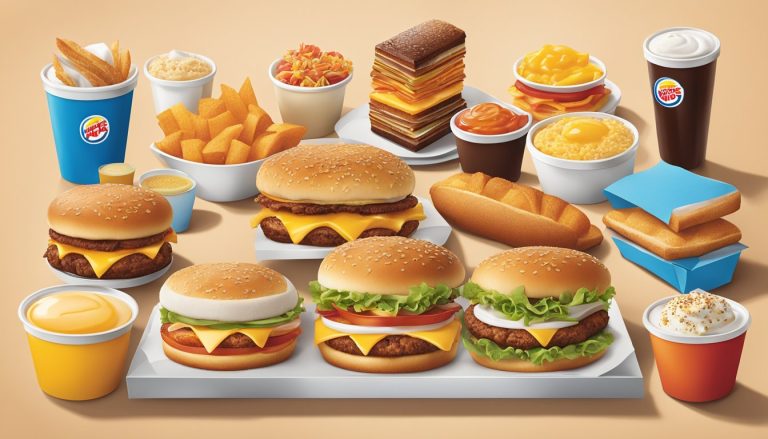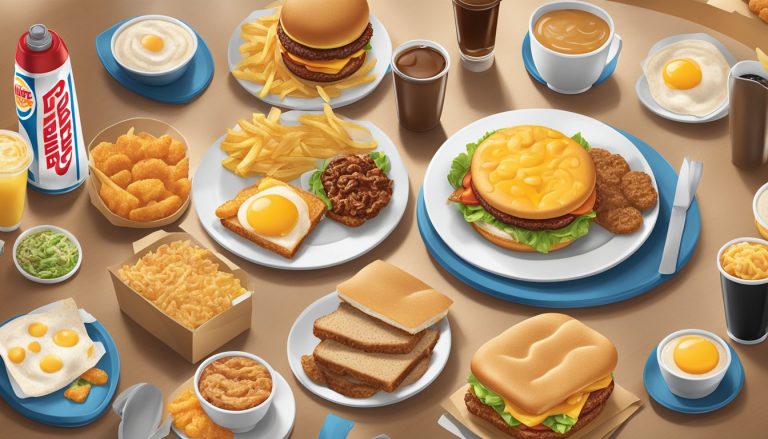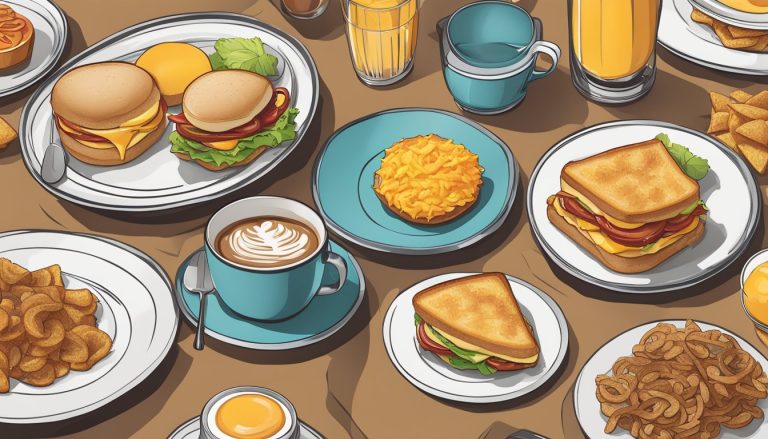Burger King has taken a significant step towards sustainability by introducing environmentally friendly packaging for its breakfast items. This move aligns with the growing consumer demand for more eco-conscious options in the fast food industry. The new packaging aims to reduce waste while maintaining the convenience that customers expect from quick-service restaurants.
Burger King’s redesigned breakfast packaging balances functionality with sustainability, featuring recyclable materials and innovative designs that minimize environmental impact. The company has focused on commonly used items like utensils, straws, and wrappers, giving them an eco-friendly makeover. This initiative is part of Burger King’s broader commitment to sustainability and waste reduction across its operations.
The introduction of sustainable breakfast packaging is just one aspect of Burger King’s multi-faceted approach to environmental responsibility. The company is also exploring reusable container programs and partnering with organizations like TerraCycle to create closed-loop systems for its packaging. These efforts demonstrate Burger King’s dedication to addressing environmental concerns while still meeting the needs of its customers.
BK’s Commitment to Sustainability

Burger King has made significant strides in its sustainability efforts, focusing on reducing environmental impact and promoting eco-friendly practices. The company has implemented various initiatives to address packaging waste and minimize its carbon footprint.
Restaurant Brands for Good
Restaurant Brands for Good is Burger King’s framework for sustainability and responsible business practices. This initiative encompasses a wide range of goals and actions aimed at improving the company’s environmental performance.
BK has set ambitious targets, including sourcing 100% of its packaging from renewable, recyclable, or certified sources by 2025. The company is also working to reduce greenhouse gas emissions by 41% per restaurant by 2030.
These commitments demonstrate BK’s dedication to addressing climate change and reducing its environmental impact across its global operations.
Sustainable Packaging Initiatives
Burger King has launched several innovative packaging initiatives to reduce waste and promote sustainability. The company is piloting a closed-loop system with zero-waste packaging through a partnership with TerraCycle’s Loop program.
This reusable packaging model aims to cut down on single-use containers and wrappers. BK is testing recyclable packaging options and exploring various methods to foster conversations about sustainable solutions.
The Loop program, initially implemented at select locations, is looking to expand. This initiative reflects BK’s commitment to finding practical ways to minimize packaging waste in the fast-food industry.
Environmental Impact of Fast Food
Fast food chains like Burger King face significant challenges in reducing their environmental footprint. BK has recognized the need to address these issues and is taking steps to mitigate its impact.
The introduction of plant-based options, such as the Impossible Whopper, represents a move towards more sustainable menu choices. This alternative helps reduce the carbon emissions associated with beef production.
BK is also focusing on energy efficiency in its restaurants and exploring ways to reduce food waste. By implementing these measures, the company aims to balance the convenience of fast food with responsible environmental practices.
Exploring BK’s Breakfast Menu

Burger King’s breakfast menu offers a diverse range of options to satisfy morning cravings. From hearty sandwiches to lighter fare, BK caters to various taste preferences and dietary needs.
The Iconic Whopper Breakfast Options
BK’s breakfast menu features Whopper-inspired offerings that bring the flavors of their signature burger to the morning table. The Breakfast Whopper combines a flame-grilled beef patty with eggs, cheese, and crispy hash browns on a sesame seed bun. For those seeking a spicier start, the Jalapeño Breakfast Whopper adds a kick with jalapeño slices and spicy sauce.
Vegetarian customers can enjoy the Plant-Based Breakfast Whopper, made with a meat-free patty and topped with egg and cheese. These breakfast iterations maintain the essence of the classic Whopper while catering to early risers.
Variety in Breakfast: From Sandwiches to Platters
BK’s breakfast menu extends beyond Whopper-inspired items. The Croissan’wich, a staple since the 1980s, comes in various combinations like sausage, bacon, or ham with egg and cheese. For a heartier option, the Double Croissan’wich doubles the meat and cheese.
Specialty sandwiches include:
- Bacon, Egg & Cheese Biscuit
- Sausage & Egg Burrito
- French Toast Sticks (served with syrup)
BK also offers breakfast platters for those with bigger appetites. These typically include scrambled eggs, hash browns, and a choice of meat like sausage or bacon.
Healthier Choices and Nutrition
BK recognizes the importance of providing nutritious breakfast options. The menu includes lighter choices such as:
- Egg and Cheese English Muffin
- Oatmeal with choice of toppings
- Fruit Cup
For calorie-conscious customers, BK provides nutrition information for all menu items. Many breakfast sandwiches can be customized by removing cheese or opting for egg whites to reduce calorie and fat content.
BK also offers coffee and fruit smoothies to complement their breakfast items, providing a range of beverage options to suit different preferences and dietary needs.
Packaging Considerations for BK Breakfast
BK’s breakfast packaging must balance convenience, customer experience, and sustainability. The materials chosen and eco-friendly innovations play crucial roles in meeting these goals.
Convenience and Customer Experience
BK prioritizes packaging that maintains food quality and temperature. Heat-insulated containers keep breakfast items warm for on-the-go customers. Microwave-safe materials allow for easy reheating.
The packaging design focuses on ease of handling. Compact, stackable containers save space in delivery vehicles and customers’ bags. Clear labeling helps identify menu items quickly.
BK’s breakfast packaging incorporates features like built-in utensils or compartments for sauces. This attention to detail enhances the overall dining experience, even when customers eat away from the restaurant.
Materials Used in BK’s Breakfast Packaging
BK utilizes a mix of materials for its breakfast packaging. Paper-based products, such as cardboard boxes and paper bags, are common for sandwiches and smaller items.
Plastic containers are used for foods that require more protection or moisture retention. BK has been working to reduce the thickness of these plastics without compromising functionality.
Foil wraps help maintain temperature for hot breakfast items. BK has explored aluminum alternatives that offer similar benefits with a lower environmental impact.
Innovations in Eco-Friendly Packaging
BK is investing in biodegradable and compostable materials for its breakfast packaging. Plant-based plastics derived from corn or sugarcane are being tested for certain containers.
The company is exploring packaging made from agricultural waste, such as wheat straw or bamboo. These materials offer a sustainable alternative to traditional paper products.
BK has implemented a minimalist design approach, reducing unnecessary packaging elements. This strategy decreases material use and simplifies the recycling process for customers.
Smart packaging technologies, like QR codes linking to digital menus, allow BK to reduce printed materials while providing customers with detailed product information.
BK’s Position in Fast Food Industry

Burger King holds a prominent position in the fast food industry, competing fiercely with other major players. The company’s market strategies and recent acquisitions have shaped its standing in the sector.
Competing with McDonald’s and Wendy’s
Burger King ranks as the second-largest fast food hamburger chain globally, behind McDonald’s but ahead of Wendy’s. BK’s signature flame-grilled burgers set it apart from competitors. The company’s menu innovations, such as the Impossible Whopper, aim to capture health-conscious consumers.
BK’s marketing often directly challenges McDonald’s, exemplified by campaigns like “The Whopper Detour.” This strategy helps BK maintain its market share and brand recognition. The company also competes on price, frequently offering deals to attract cost-sensitive customers.
BK’s Market Strategies
BK targets a broad demographic, with a focus on the adult market. The company emphasizes customization, allowing customers to “have it your way.” This approach appeals to individuals seeking personalized dining experiences.
BK’s international expansion forms a key part of its growth strategy. The company adapts its menu to local tastes in different countries, balancing global brand consistency with regional preferences.
Digital initiatives, including mobile ordering and delivery partnerships, have become increasingly important for BK. These efforts aim to enhance customer convenience and capture a larger share of the growing food delivery market.
The Impact of Acquisitions on BK
The acquisition of BK by 3G Capital in 2010 marked a significant turning point for the company. This move led to cost-cutting measures and a renewed focus on franchise growth.
In 2014, 3G Capital and Berkshire Hathaway acquired Tim Hortons and merged it with BK to form Restaurant Brands International. This merger expanded BK’s portfolio and increased its global presence.
The acquisition of Popeyes Louisiana Kitchen in 2017 further diversified Restaurant Brands International’s offerings. This move allowed BK to benefit from shared resources and expertise across multiple fast food brands.
Customer Favorites and Menu Variants

Burger King’s menu offers a diverse array of options to satisfy various tastes and preferences. The iconic Whopper anchors the lineup, complemented by specialty sandwiches and fish selections that cater to different dietary needs and flavor profiles.
Exploring the Range of Whopper Sandwiches
The Whopper remains BK’s signature item, featuring a flame-grilled beef patty topped with fresh vegetables and condiments. Variants include the Double Whopper, Whopper Jr., and Impossible Whopper for plant-based eaters.
BK often introduces limited-time Whopper variations to keep the menu exciting. These may feature unique toppings, spicy flavors, or seasonal ingredients.
The Whopper’s customizable nature allows customers to add or remove toppings, creating a personalized experience.
BK Specialty Sandwiches and Variants
Beyond the Whopper, BK offers an array of specialty sandwiches. The Original Chicken Sandwich, a long-standing menu item, features a breaded chicken fillet with lettuce and mayo.
The BK Stacker series caters to hearty appetites, allowing customers to choose from single to quad beef patties with cheese and bacon.
For those seeking bolder flavors, BK periodically introduces spicy chicken options or sandwiches with unique sauce combinations.
The BK XXL line pushes portion sizes to the extreme, satisfying customers looking for larger, more indulgent options.
Fish Selections and Alternatives
BK’s fish offerings provide alternatives for non-meat eaters or those observing dietary restrictions. The classic BK Big Fish features a breaded white fish fillet with tartar sauce and lettuce.
Seasonal promotions sometimes bring limited-time fish options to the menu, such as fish wraps or sandwiches with special toppings.
BK has expanded its menu to include more plant-based alternatives, catering to vegetarian and vegan customers with options like plant-based nuggets.
These fish and alternative protein choices help BK maintain a diverse menu that appeals to a wide range of dietary preferences and restrictions.
Complementary Offerings

Burger King’s breakfast menu extends beyond the main dishes, offering a variety of sides, desserts, and beverages to enhance the morning meal experience. These complementary items provide options to customize and round out breakfast orders.
From Sides to Desserts
BK’s breakfast sides include crispy hash browns and french fries, perfect for those craving a savory crunch. For a sweeter start, customers can choose from cinnamon rolls or warm pancakes drizzled with syrup. The chain also offers apple pie slices as a dessert option, combining flaky crust with a warm apple filling. These items come in sustainable packaging, aligning with BK’s eco-friendly initiatives. Portion sizes vary to accommodate different appetites, from small hash brown bites to full-sized pancake stacks.
Beverages to Pair with Breakfast
BK provides a range of beverages to complement its breakfast offerings. Hot coffee, available in regular and decaf, is a morning staple. For those preferring cold drinks, iced coffee and soft drinks are on the menu. Fruit juices offer a refreshing alternative, while milk serves as a classic breakfast beverage. BK also features milkshakes in various flavors, bridging the gap between drink and dessert. The chain uses recyclable cups and lids for most beverages, supporting its sustainability goals while ensuring convenience for on-the-go customers.
Adapting to Global Markets

Burger King has made significant strides in customizing its offerings for different international markets. The company recognizes the importance of catering to local tastes and cultural preferences to succeed globally.
BK’s Menu Adaptations for India
Burger King’s entry into India required careful menu adjustments. The company introduced vegetarian options like the Vegetable Whopper and Paneer King Melt to appeal to the large vegetarian population. BK also launched chicken and mutton variants of popular items to cater to non-beef eaters.
The introduction of rice-based meals and spicy offerings aligns with Indian culinary preferences. BK’s fish tenders, a unique item for the Indian market, have gained popularity among coastal regions. These adaptations demonstrate BK’s commitment to understanding and meeting local tastes.
Cultural Sensitivity and Menu Customization
BK’s approach to cultural sensitivity extends beyond India. In Muslim-majority countries, the company ensures all meat is halal-certified. In Japan, BK offers teriyaki-flavored burgers and unique items like black buns made with bamboo charcoal.
The BK Broiler, a grilled chicken sandwich, has been adapted for various markets with local spices and toppings. In France, BK introduced wine-flavored burgers to appeal to local tastes. These customizations show BK’s flexibility in adapting its core menu to suit different cultural preferences and dietary restrictions.
Innovations in Restaurant Design

BK is reimagining restaurant spaces to enhance customer experience and operational efficiency. These changes reflect broader trends shaping the future of fast food dining environments.
Enhancing the BK Experience
BK has introduced modular kitchen designs to streamline food preparation. These layouts optimize workflow, reducing wait times for customers. Digital menu boards now feature dynamic pricing and promotional content, enhancing visual appeal and flexibility.
Self-service kiosks have become a staple, allowing customers to customize orders easily. This technology reduces lines and improves order accuracy. BK has also implemented mobile ordering and dedicated pickup areas, catering to on-the-go customers.
Seating areas now feature a mix of traditional tables and high-top counters with charging stations. This variety accommodates different dining preferences and tech needs. Improved lighting and acoustics create a more comfortable atmosphere for dine-in guests.
Future Trends in Fast Food Spaces
BK and other chains are exploring drive-thru innovations. Multi-lane configurations and AI-powered ordering systems are set to reduce wait times and boost efficiency. Some locations are testing conveyor belt pickup windows for a contactless experience.
Sustainability is driving design choices. Energy-efficient lighting, HVAC systems, and kitchen equipment are becoming standard. Restaurants are incorporating recycled materials and greenery to create eco-friendly dining spaces.
Virtual restaurant concepts are gaining traction. These kitchen-only locations cater exclusively to delivery and takeout orders, optimizing space utilization. BK is considering this model to expand its reach in urban areas.




